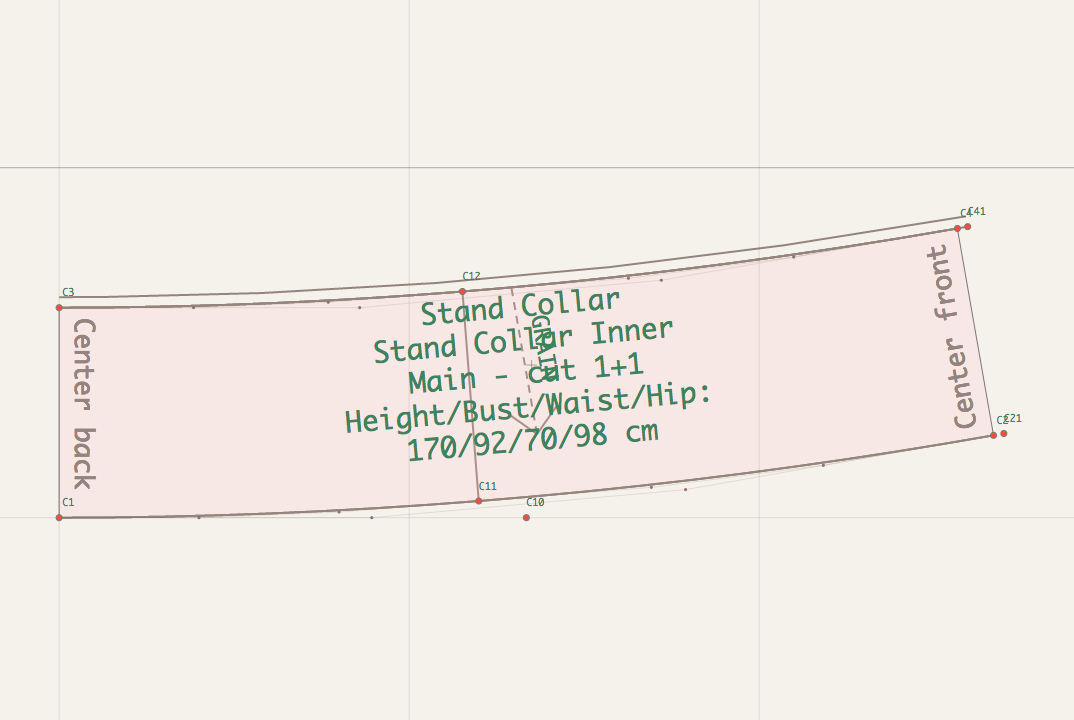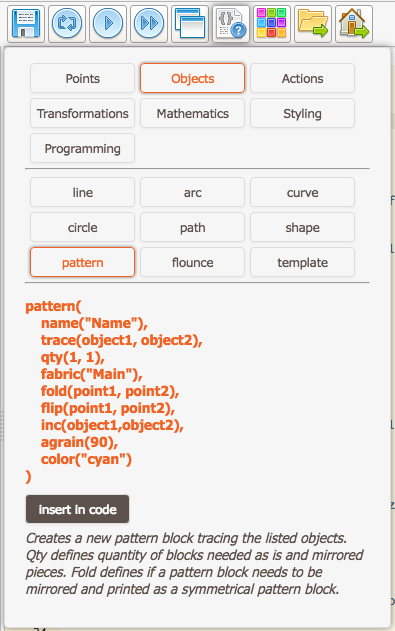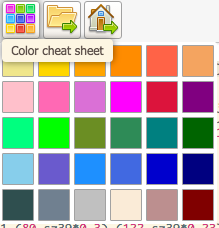pattern (name(), trace(), qty(), fabric(), fold(), flip(), grain(), inc(), color(), outline(), seam(), extra())
pattern
name
trace
qty
fabric
fold
flip
grain
inc
color
outlint
seam
extra
Pattern function creates pattern pieces, and uses many parameters.

This function has the biggest number of options, though many of them can be omitted. We recommend using the code help button and using code template for pattern function under objects (see on the right). Simply click the button to insert this template into code and replace or delete parameters as required.

All parameters are given in brackets and are separated by commas.
You may assign a name to a pattern piece if you plan to refer to it later, e.g. if you plan to apply pleats, mirror or move the pattern piece, however it is not mandatory. In case you need to name the pattern object, use syntax
name("text") - name of the pattern piece.
This parameter is mandatory.
It should be given as a string (text) in quotes, e.g.
trace(object1,object2) - pattern contour.
This parameter is mandatory and describes the sequence of objects forming the contour of a pattern piece.
- The objects must be given clockwise and their direction should be taken into consideration. For example if a curve or a line has opposite direction, it should be included with a minus sign, e.g.
- If the objects' ends don't meet, they are connected with straight line. Same happens with a sequence of points. For example to describe a square you only need to mention the corner points, e.g.
qty(number1,number2) - quantity of pieces required.
Can be omitted and equals (1,0) by default.
The first number refers to pieces cut as is, the second refers to mirrored pieces. E.g.
- Texts on pattern pieces will be generated accordingly.
- Only one piece will be included into real size print out. Small size printout will have all the pieces, and some of them will be mirrored.
fabric("text") - fabric to be used for pattern piece.
Can be omitted and equals "Self" by default.
- If several fabrics are to be used, they should be separated by comma, e.g.
- The real size printout will only have one piece.
- The small printout will have pieces for both fabrics.
- The lists of pattern pieces for instructions and spec sheet will be generated accordingly.
fold(point1,point2) - the future fold line on the pattern.
Can be omitted, is not included by default.
- Make sure you trace the pattern in such a way that the fold line is between the first and the last point of the contour.
- A fold mark is added automatically on the edge.
- If a fold line is mentioned, the text on pieces is generated accordingly, e,g, "cut 1 on fold".
- The piece will have the other half in the small printout, and its area will be calculated as a whole in the spec sheet.
- The software will not draw the second half of a pattern on real size printout, so that fewer sheets have to be printed out.
flip(point1,point2) - draws the second half of the pattern.
Can be omitted, is not included by default.
If a shape of a pattern piece is very complex and it is tricky to cut it on fold making sure it stays precise, you may choose to print it out as a whole. You only need to mention the flip line and the software will draw the second half of the pattern piece and include all marks, texts, lines etc, that are present in the first half. In this case the pattern will have both halves traced and printed out in real size and small printouts.
grain(angle) - the angle of grain line on the pattern.
Can be omitted, equals 90 by default.
- You may use math expressions and refer to properties of other objects in this parameter, e.g.
- The software will draw a dashed line across the pattern piece and mark it as GRAIN (see above). inc(objects) - the objects that should be included into the pattern piece, e.g. texts, marks, other objects that need to be printed within the pattern (e.g. darts).
You may also describe a sequence of points, and it will be included as a line, or a path if you mention more than 2 points. E.g.
color("name or hex code") - the color of a pattern piece on the screen and in small size printout
Can be omitted, equals "coral" by default.
E.g. in the top navigation above the code window. Simply click a color and its name will be inserted at the current position of cursor.
in the top navigation above the code window. Simply click a color and its name will be inserted at the current position of cursor.

outline("name or hex code") - the color of the contour of a pattern piece on real size printout, usually referred to as color coding pattern blocks
Can be omitted, equals "black" by default.
E.g. in the top navigation above the code window. Simply click a color and its name will be inserted at the current position of cursor.
in the top navigation above the code window. Simply click a color and its name will be inserted at the current position of cursor.
Tip: Traditionally, color coding is as follows:
seam(float or name of a variable)
Can be omitted, equals 0 by default.
E.g.
extra( (point1,point2,float or name of variable),...,(point3,point4,float or name of variable) )
Can be omitted, equals 0 by default.
Defines specific seam allowance between two points along the contour, to be mentioned clockwise. Points can be referred by names or properties of objects, for example:
Tip: Seam allowances depend on the fabric choice and usually are as follows:

This function has the biggest number of options, though many of them can be omitted. We recommend using the code help button and using code template for pattern function under objects (see on the right). Simply click the button to insert this template into code and replace or delete parameters as required.

All parameters are given in brackets and are separated by commas.
You may assign a name to a pattern piece if you plan to refer to it later, e.g. if you plan to apply pleats, mirror or move the pattern piece, however it is not mandatory. In case you need to name the pattern object, use syntax
rightfront=(pattern.....Function parameters
This parameter is mandatory.
It should be given as a string (text) in quotes, e.g.
name("Front"),This parameter is mandatory and describes the sequence of objects forming the contour of a pattern piece.
- The objects must be given clockwise and their direction should be taken into consideration. For example if a curve or a line has opposite direction, it should be included with a minus sign, e.g.
trace(p1,-curve1,-line1,path2),, just as when describing a continuous path.- If the objects' ends don't meet, they are connected with straight line. Same happens with a sequence of points. For example to describe a square you only need to mention the corner points, e.g.
trace(p1,p2,p3,p4),Can be omitted and equals (1,0) by default.
The first number refers to pieces cut as is, the second refers to mirrored pieces. E.g.
qty(1,0), stands for one piece cut as is, qty(1,1), stands for 1 piece cut as is and 1 mirrored piece, e.g. right and left front.- Texts on pattern pieces will be generated accordingly.
- Only one piece will be included into real size print out. Small size printout will have all the pieces, and some of them will be mirrored.
Can be omitted and equals "Self" by default.
- If several fabrics are to be used, they should be separated by comma, e.g.
fabric("Self"), or fabric("Self, Interfacing"),.- The real size printout will only have one piece.
- The small printout will have pieces for both fabrics.
- The lists of pattern pieces for instructions and spec sheet will be generated accordingly.
Can be omitted, is not included by default.
- Make sure you trace the pattern in such a way that the fold line is between the first and the last point of the contour.
- A fold mark is added automatically on the edge.
- If a fold line is mentioned, the text on pieces is generated accordingly, e,g, "cut 1 on fold".
- The piece will have the other half in the small printout, and its area will be calculated as a whole in the spec sheet.
- The software will not draw the second half of a pattern on real size printout, so that fewer sheets have to be printed out.
Can be omitted, is not included by default.
If a shape of a pattern piece is very complex and it is tricky to cut it on fold making sure it stays precise, you may choose to print it out as a whole. You only need to mention the flip line and the software will draw the second half of the pattern piece and include all marks, texts, lines etc, that are present in the first half. In this case the pattern will have both halves traced and printed out in real size and small printouts.
Can be omitted, equals 90 by default.
- You may use math expressions and refer to properties of other objects in this parameter, e.g.
grain([y1:s1].a1+curve1.a2),- The software will draw a dashed line across the pattern piece and mark it as GRAIN (see above).
You may also describe a sequence of points, and it will be included as a line, or a path if you mention more than 2 points. E.g.
inc(text_center_front,front_hip_mark,(p1,p2),line1),Can be omitted, equals "coral" by default.
E.g.
color("cyan") or color("#FF0000"). You may also use the color cheat sheet button  in the top navigation above the code window. Simply click a color and its name will be inserted at the current position of cursor.
in the top navigation above the code window. Simply click a color and its name will be inserted at the current position of cursor.
Can be omitted, equals "black" by default.
E.g.
outline("cyan") or outline("#FF0000"). You may also use the color cheat sheet button  in the top navigation above the code window. Simply click a color and its name will be inserted at the current position of cursor.
in the top navigation above the code window. Simply click a color and its name will be inserted at the current position of cursor.Tip: Traditionally, color coding is as follows:
| Pattern block fabric | color | |
| Self | black | |
| Lining | blue | |
| Contrast | purple | |
| Trim | green | |
| Interfacing | red |
Can be omitted, equals 0 by default.
E.g.
seam(1) or seam(sas) The default seam allowance that is added to all edges of a pattern block, except for the edge marked for fold line.Can be omitted, equals 0 by default.
Defines specific seam allowance between two points along the contour, to be mentioned clockwise. Points can be referred by names or properties of objects, for example:
extra((ls2,l2,sah),(armhole.p1,armhole.p2,0.7))Tip: Seam allowances depend on the fabric choice and usually are as follows:
| Seam allowance | cm | in |
| General seaming | 1 cm | 3/8" |
| Tight curves | 0.7 cm | 1/4" |
| Hem by hand, light fabric | 1.5 cm | 5/8" |
| Hem by hand, designer dresses | 7.5 cm | 3" |
| Invisible zipper, light fabric | 1.3 cm | 1/2" |
| Zipper, jackets etc | 2 cm | 3/4" |
| Lower edge of facings | 0 cm | 0" |